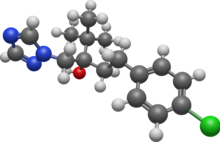
| |

| |
| Names | |
|---|---|
| IUPAC name
(RS)- 1-(4-Chlorophenyl)- 4,4-dimethyl-3-(1H, 1,2,4-triazol-1-ylmethyl)pentan- 3-ol
| |
| Other names
(±)-1-(4-Chlorophenyl)-4,4-dimethyl-3-(1H, 1,2,4-triazol-1-ylmethyl)pentan-3-ol
| |
| Identifiers | |
3D model (JSmol)
|
|
| ChEBI | |
| ChEMBL | |
| ChemSpider | |
| ECHA InfoCard | 100.100.535 |
PubChem CID
|
|
| UNII | |
CompTox Dashboard (EPA)
|
|
| |
| |
| Properties | |
| C16H22ClN3O | |
| Molar mass | 307.82 g·mol−1 |
| Density | 1.249 g/cm3 at 20 °C |
| Melting point | 102.4 °C (216.3 °F; 375.5 K) |
| 0.032 g/L at 20 °C | |
Except where otherwise noted, data are given for materials in their standard state (at 25 °C [77 °F], 100 kPa).
| |
Tebuconazole is a triazole fungicide used agriculturally to treat plant pathogenic fungi.
Environmental Hazards[edit]
Though the U.S. Food and Drug Administration considers this fungicide to be safe for humans, it may still pose a risk. It is listed as a possible carcinogen in the United States Environmental Protection Agency Office of Pesticide Programs carcinogen list with a rating of C (possible carcinogen). Its acute toxicity is moderate.[2] According to the World Health Organization toxicity classification, it is listed as III, which means slightly hazardous.[citation needed]
Due to the potential for endocrine-disrupting effects, tebuconazole was assessed by the Swedish Chemicals Agency[3] as being potentially removed from the market by EU regulation 1107/2009.[4]
References[edit]
- ^ Tebuconazole, - Archived 2011-04-29 at the Wayback Machine Food and Agriculture Organization of the United Nations
- ^ EPA regulation on Tebuconazole Archived 2006-04-27 at the Wayback Machine
- ^ "Interpretation of criteria for approval of active substances in the proposed EU plant protection regulation". Swedish Chemicals Agency (KemI). 2008-09-23. Archived from the original on 2009-01-01. Retrieved 2009-01-14.
- ^ "European regulation 1107/2009". 2009-10-21. Retrieved 2010-10-28.
Well, that’s interesting to know that Psilotum nudum are known as whisk ferns. Psilotum nudum is the commoner species of the two. While the P. flaccidum is a rare species and is found in the tropical islands. Both the species are usually epiphytic in habit and grow upon tree ferns. These species may also be terrestrial and grow in humus or in the crevices of the rocks.
View the detailed Guide of Psilotum nudum: Detailed Study Of Psilotum Nudum (Whisk Fern), Classification, Anatomy, Reproduction